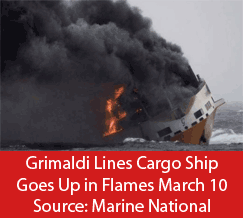In Q1 2019, SCDigest reported on growing industry concerns after a series of containership fires in 2018 and early 2019. (See Spate of Recent Cargo Ship Fires has Industry Worried.)
That included a major fire on the Maersk Honam in 2018. The ship was in route from Singapore to the Suez Canal when a fire broke out in its cargo hull some 1,000 miles off the Oman coast. Five of the 27 Homan crew members were killed in the fast moving blaze, which took weeks to extinguish after the surviving crew members were rescued.
Supply Chain Digest Says... |
|
|
The key question then: were the string of fires a strange coincidence – or something more?
"It was a wake-up call," Maersk executive Ole Graa Jakobsen said of the Honam fire at the time, the cause of which is still undetermined.
Since then, Maersk stopped stowing perceived dangerous cargo below deck, as well as with other goods considered resistant to fire fighting.
And insurance company TT Club, which is a major player in the logistics sector, estimated that some two-thirds of all incidents are the result of "poor practice in the overall packing process" of dangerous goods, which are often misidentified or undeclared.
That position was seemingly supported by a new report from the independent National Cargo Bureau (NCB), New York-based organization group that assists the US Coast Guard with data and policies relative to maritime safety.
The year-long NCB analysis found a significant percentage of dangerous-goods moved on international cargo ships were mislabeled or improperly handled and had other safety risks. That finding is in concert with the views of many container shipping lines after the string of fires that many of them believed were being caused by potentially dangerous shipments being loaded without proper identification.
The NCB performed analysis on 500 shipping container from around the world carried by either Maersk, CMA CGM, or Hapag-Lloyd. Maersk initially proposed the analysis be performed. Each of the three companies had a different method for targeting which containers they wanted inspected.
The study found that 274 containers, or 55% of the 500 studied, carried freight with potential fire hazards. Of the containers coming into the US with the dangerous cargo, the analysis found that 69% were either not properly secured, lacked warning signs on container, or involved cargo that was incorrectly identified on shipping documents.
(See More Below)
|
CATEGORY SPONSOR: SOFTEON |
|
|
|
|
|
51% of containers carrying non-dangerous goods had similar problems.
 More specifically, for the containers coming into the US with dangerous goods, 44% had problems with the way cargo was secured, 39% had improper placarding and 8% had mis-declared cargo. More specifically, for the containers coming into the US with dangerous goods, 44% had problems with the way cargo was secured, 39% had improper placarding and 8% had mis-declared cargo.
Of a group of export containers with dangerous goods leaving the US, 25% had securing issues, 15% were improperly placarded and 5% were mis-declared. However, some of the mis-declarations did not create safety issues.
"The figures on how much improperly stowed or mis-declared cargo was in the boxes were shocking," NCB President Ian Lennard said.
The NCB report has been submitted to the International Maritime Organization (IMO), which makes rules for ocean shipping.
The report is timely, as the number of serious container ship fires continues to rise. The NCB says that there were nine major fires on large container ships to date in 2019, compared with just one- the Maersk Honam - in 2018 and two in 2017.
Eight of those nine serious fires were listed by the container shipping analysts at Drewry a few month back:
8 of the 9 Serious Container Shp Fires to Date in 2019

Source: Drewry
However, there are many lesser fires on ships that never get recorded.
"Few incidents make it into a report," Andrew Kinsey, a senior marine risk consultant at Allianz Global Corporate and Specialty, the commercial insurance arm of German insurer Allianz SE, told the Wall Street Journal. "If the incident does not involve loss of life and doesn't make headlines, it often goes unreported."
The Wall Street Journal reports that dangerous goods that might ignite a fire include charcoal, fertilizer, fish food, chlorine products and many other chemicals, car batteries and electronic components. Additionally, cargo that isn't properly secured can shift inside its container during shipping, creating heat from friction that can also cause a fire.
Interestingly, some ocean shipping exports cite the growth of ecommerce as contributing to the risk, as the number of suppliers shipping products on container grows, many with little experience in shipping regulations, contributes to the problem.
The report thatt was delivered to the IMO states that "the increasing number of casualties related to container fires during the past years suggests that the problem is exacerbating, despite provisions in the International Maritime Dangerous Goods Code and other carrier initiatives to identify undeclared and mis-declared dangerous cargo being tendered for carriage."
With the number of container fires rapidly escalating, some carriers have announced that they would levy penalties on shippers for mis-declaring cargoes. Hapag-Lloyd, for example, now fines shippers $15,000 for undeclared or mis-declared hazardous cargoes. HMM will fine the same amount, while Evergreen announced a penalty of $35,000. OOCL said that it is tightening its dangerous cargo acceptance with an additional verification step.
Do you think cargo issues are what are causing these fires? What should be done? Let us know your thoughts at the Feedback section below.
Your Comments/Feedback
|